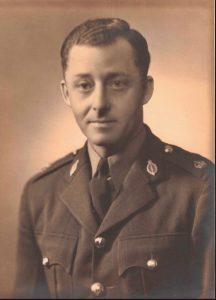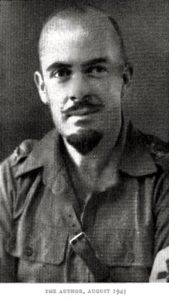THE VOLUNTEER FORCES -MOST OFTEN REFERRED TO AS ‘VULTURES’
Volunteers or ‘Vultures’ as they often preferred, answered their country’s call in the years running up to WW2, particularly after the outbreak of war in Europe in 1939.
They came from all nationalities and walks of life in the pre-war peninsula known as British Malaya. The Volunteers were not only Europeans, but Malays, Chinese, Indians and Eurasians. They came from all branches of the Malayan Government Service, from the Mines and Plantations, from the business communities, from the Medical Profession and from the Church. Many other civilians who would have joined the Volunteers, were prevented from doing so because they were in so-called ‘reserved occupations’ considered essential for the continued smooth running of the country. Whatever their background, they were motivated by a profound sense of wanting to do everything in their power to defend the Crown Colony of Malaya and her dependents.
The Volunteer Forces were similar in concept to the British Territorial Army, but were organised within 3 separate groups according to which administrative area of Malaya they came from. Officers held a Governor’s Commission instead of a King’s Commission. The three political entities were The Straits Settlements were administered by a British Governor (Sir Shenton Thomas) who was also High Commissioner for the eleven Malay States.The Straits Settlements consisted of Singapore, Penang and the Province Wellesley, and Malacca (and Labuan and Christmas Island). Volunteers were organised into 4 Battalions:-
A. The Crown Colony of the Straits Settlements (S.S.)
Singapore – 1st and 2nd Battalion S.S.V.F (1250 men)
Penang & Province Wellesley – 3rd Battalion S.S.V.F. (916 men)
Malacca – 4th Battalion S.S.V.F. (675 men)
B. The Federated Malay States (F.M.S.)
These States were ruled by Sultans, but each had a British Resident to whom they were accountable.The Federated Malay States consisted of Perak, Selangor, Negri Sembilan and Pahang. Volunteers from these States were also organised into 4 Battalions:
Perak – 1st Battalion F.M.S.V.F.
Selangor – 2nd Battalion F.M.S.V.F.
Negri Sembilan – 3rd Battalion F.M.S.V.F.
Pahang – 4th Battalion F.M.S.V.F.
There was also a F.M.S.V.F. Signals Battalion,
F.M.S.V.F.Light (Artillery) Battery,
F.M.S.V.F. Reserve Motor Transport Company
and F.M.S.V.F. Field Ambulance units.
F.M.S.V.F. Federated Malay States Volunteer Force. Total number of men: 5,200
C. The Unfederated Malay States (U.M.S.)
Each of these States was ruled by a Sultan and each had a British Advisor with far less influence than the British Residents of the F.M.S. These 5 States were Johore, Kedah, Kelantan, Trengganu and Perlis. Apart from Johore, they were the more northerly States with fewer Europeans and more tenuous lines of communication. Volunteers from these States were, perhaps, less well organised,again with the exception of Johore, and deployed into Local Defence Corps or Forces, rather than Battalions with a more formal command structure.
Volunteers were organised into the following groups:
Johore – J.V.E. (Johore Volunteer Engineers) – 258 men.
Kedah – K.V.F. (Kedah Volunteer Force) – 571 men.
Kelantan – K.V.F. (Kelantan Volunteer Force) – 136 men.
Trengganu & Perlis – no regular Defence Force or Corps.
As well as these Volunteer groupings, there were also Local Defence Corps, similar to the Home Guard, throughout Malaya. Some Malayan Volunteers joined:
-
The Malayan Royal Navy Volunteer Reserve (M.R.N.V.R.) – 1083 men
-
The Malayan Volunteer Air Force (M.V.A.F.) – 350 men.
-
The Armoured Car Squadrons under S.S. & F.M.S. commands. In the final days the F.M.S.V.F Armoured Car units were amalgamated and given regimental status.
-
The Singapore Royal Artillery and Singapore Royal Engineers.
-
SOE – particularly in the form of Stay Behind Parties. Volunteers participating in these were given General List Commissions.
The Volunteers were of enormous help to the thousands of captured British, Australian and Indian Forces who became POWs, especially those who had only been in the Far East for a matter of weeks before capture. They knew and understood the local languages and the people, particularly those who remained loyal to the British and wanted to help them. They were acclimatised to the conditions, which must have been difficult to adjust to for the newly arrived troops – most of whom had received no training in jungle warfare.
They understood the prevalent diseases such as Malaria and Dengue Fever, how best to avoid them, and the medicines that were needed to control them.
They were able to barter with the local traders for food and medicine, and to set up a system of ‘listening posts’ for information, especially in the early months of imprisonment.
Working on the Burma-Thai Railway some Volunteers/Vultures were able to speak Thai and make contact with the local Thai and/or Thai Chinese population, to get the extra food and medicines so urgently needed by the starving and desperately ill POWs.
The end of war and gaining their freedom proved a difficult and sometimes challenging time for so many Volunteers – the homes they knew were no longer as were their occupations. Some wives and children had fled safely from Singapore but most had been incarcerated in appalling conditions by the Japanese.
For many regular soldiers who had became POWs and had ‘survived’ their incarceration – a large number had received some mail from home. At the same time, many soldiers received no mail and did not know about their families – however when war’s end came, the soldiers could at least (hopefully) return to their homes and families
Please read the story of Francis George Charlesworth, Vol Light Artillery Battery, FMSVF

Above: Charlesworth
Known Books by Volunteers/Vultures
Bamboo Doctor by Dr Stanley Pavillard [Macmillan & Co. London 1960 or Pan Books 1962]

Please read further about Pavillard
